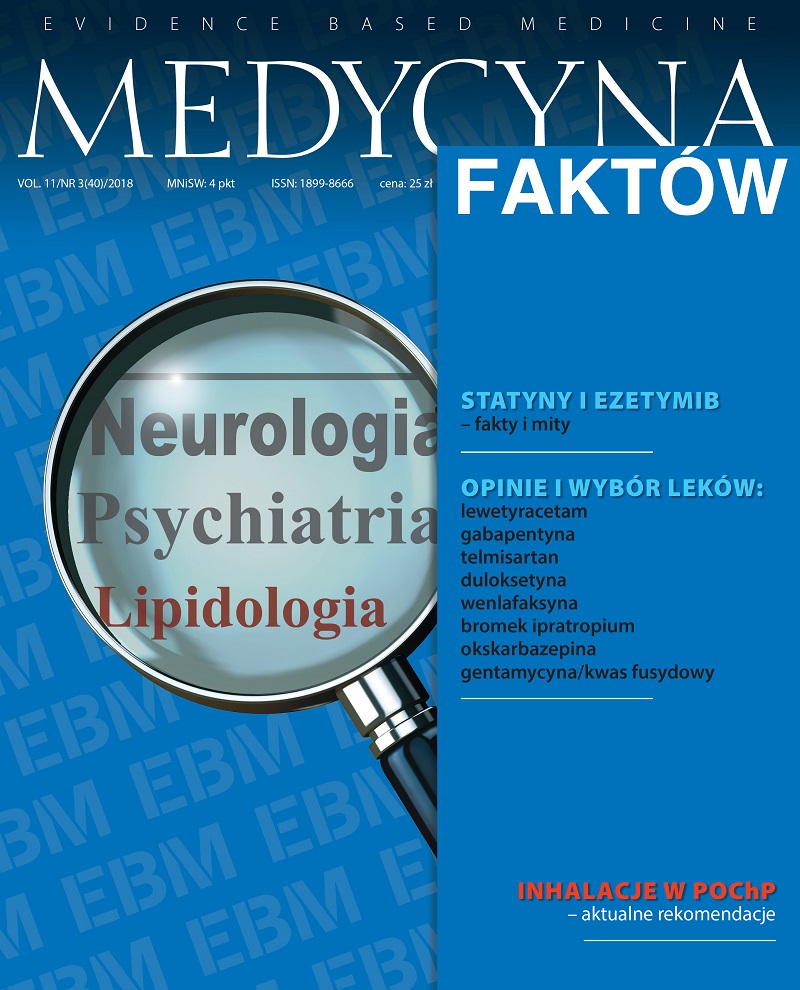Kaszel poinfekcyjny – patomechanizm i rola bromku ipratropium w leczeniu Artykuł przeglądowy
##plugins.themes.bootstrap3.article.main##
Abstrakt
Ostry kaszel nierzadko stanowi następstwo infekcji górnych dróg oddechowych i początkowo może upośledzać jakość życia, ale najczęściej ustępuje samoistnie i nie wymaga istotnego leczenia. Długość utrzymywania się kaszlu po epizodzie infekcji górnych dróg oddechowych może być bardzo różna, ale rzadko przekracza 2 tygodnie. Optymalny sposób leczenia kaszlu poinfekcyjnego nie jest jednoznacznie określony. Leki rozszerzające oskrzela, w tym leki antycholinergiczne oraz β2-agoniści w monoterapii lub w połączeniu, są szeroko stosowane w leczeniu ostrego i przewlekłego kaszlu różnego pochodzenia.
##plugins.themes.bootstrap3.article.details##
Jak cytować
Postuła , M. (2018). Kaszel poinfekcyjny – patomechanizm i rola bromku ipratropium w leczeniu . Medycyna Faktów , 11(3(40), 224-227. https://doi.org/10.24292/01.MF.0318.9
Numer
Dział
Artykuły
Copyright © by Medical Education. All rights reserved.
Bibliografia
1. Lee A.M., Jacoby D.B., Fryer A.D.: Selective muscarinic receptor antagonists for airway diseases. Curr. Opin. Pharmacol. 2001; 1(3): 223-229.
2. Irwin R.S., Baumann M.H., Bolser D.C. et al.: Diagnosis and management of cough executive summary: ACCP evidence-based clinical practice guidelines. Chest 2006; 129(1 supl.): 1S.
3. Bateman E.D., Rennard S., Barnes P.J. et al.: Alternative mechanisms for tiotropium. Pulmon. Pharmacol. Ther. 2009; 22(6): 533-542.
4. Korpas J., Widdicombe J.G.: Aspects of the cough reflex. RespirMed. 1991; 85(supl.): 3-5.
5. Barnes P.J.: State of the art: neural control of human airways in health and disease. Am. Rev. Respir. Dis. 1986; 134: 1289-1314.
6. Korpas J., Tomori Z.: Cough and Other Respiratory Reflexes. Karger, Basel 1979.
7. Pounsford J.: Cough and bronchoconstriction. Clin. Respir. Physiol. 1987; 23(supl.): 37-40.
8. Barnes P.J.: Muscarinic receptors in lung. Postgrad. Med. J. 1987; 63(supl.): 13-19.
9. Gosens R., Zaagsma J., Meurs H., Halayko A.J.: Muscarinic receptor signaling in the pathophysiology of asthma and COPD. Respir. Res. 2006; 7: 73.
10. Salari H., Chan-Yeung M.: Release of 15-hydroxyeicosatetraenoic acid (15-HETE) and prostaglandin E2 (PGE2) by cultured human bronchial epithelial cells. Am. J. Respir. Cell. Mol. Biol. 1989; 1(3): 245-250.
11. Pounsford J.C., Birch M.J., Saunders K.B.: Effect of bronchodilators on the cough response to inhaled citric acid in normal and asthmatic subjects. Thorax 1985; 40(9): 662e7.
12. Holmes P.W., Barter C.E., Pierce R.J.: Chronic persistent cough: use of ipratropium bromide in undiagnosed cases following upper respiratory tract infection. Respir. Med. 1992; 86: 425-429.
13. Zanasi A., Lecchi M., Del Forno M. et al.: A randomized, placebo-controlled, double-blind trial on the management of post-infective cough by inhaled ipratropium and salbutamol administered in combination. Pulm. Pharmacol. Ther. 2014; 29(2): 224-232.
14. Johnston S.L., Holgate S.T.: Epidemiology of respiratory tract infections. W: Myint S., Taylor-Robinson D. (red.): Viral other infections of the human respiratory tract. Chapman & Hall, London 1996.
15. Reid D.D., Williams R.E., Hirch A.: Colds among office workers, an epidemiological study. Lancet 1953; 265: 1303-1306.
16. Morice A.H.: Epidemiology of cough. Pulm. Pharmacol. Ther. 2002; 15: 253-259.
2. Irwin R.S., Baumann M.H., Bolser D.C. et al.: Diagnosis and management of cough executive summary: ACCP evidence-based clinical practice guidelines. Chest 2006; 129(1 supl.): 1S.
3. Bateman E.D., Rennard S., Barnes P.J. et al.: Alternative mechanisms for tiotropium. Pulmon. Pharmacol. Ther. 2009; 22(6): 533-542.
4. Korpas J., Widdicombe J.G.: Aspects of the cough reflex. RespirMed. 1991; 85(supl.): 3-5.
5. Barnes P.J.: State of the art: neural control of human airways in health and disease. Am. Rev. Respir. Dis. 1986; 134: 1289-1314.
6. Korpas J., Tomori Z.: Cough and Other Respiratory Reflexes. Karger, Basel 1979.
7. Pounsford J.: Cough and bronchoconstriction. Clin. Respir. Physiol. 1987; 23(supl.): 37-40.
8. Barnes P.J.: Muscarinic receptors in lung. Postgrad. Med. J. 1987; 63(supl.): 13-19.
9. Gosens R., Zaagsma J., Meurs H., Halayko A.J.: Muscarinic receptor signaling in the pathophysiology of asthma and COPD. Respir. Res. 2006; 7: 73.
10. Salari H., Chan-Yeung M.: Release of 15-hydroxyeicosatetraenoic acid (15-HETE) and prostaglandin E2 (PGE2) by cultured human bronchial epithelial cells. Am. J. Respir. Cell. Mol. Biol. 1989; 1(3): 245-250.
11. Pounsford J.C., Birch M.J., Saunders K.B.: Effect of bronchodilators on the cough response to inhaled citric acid in normal and asthmatic subjects. Thorax 1985; 40(9): 662e7.
12. Holmes P.W., Barter C.E., Pierce R.J.: Chronic persistent cough: use of ipratropium bromide in undiagnosed cases following upper respiratory tract infection. Respir. Med. 1992; 86: 425-429.
13. Zanasi A., Lecchi M., Del Forno M. et al.: A randomized, placebo-controlled, double-blind trial on the management of post-infective cough by inhaled ipratropium and salbutamol administered in combination. Pulm. Pharmacol. Ther. 2014; 29(2): 224-232.
14. Johnston S.L., Holgate S.T.: Epidemiology of respiratory tract infections. W: Myint S., Taylor-Robinson D. (red.): Viral other infections of the human respiratory tract. Chapman & Hall, London 1996.
15. Reid D.D., Williams R.E., Hirch A.: Colds among office workers, an epidemiological study. Lancet 1953; 265: 1303-1306.
16. Morice A.H.: Epidemiology of cough. Pulm. Pharmacol. Ther. 2002; 15: 253-259.
